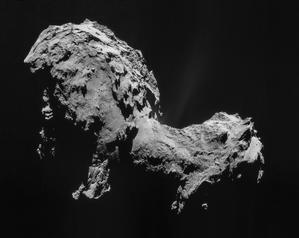Glossary term: 彗核
Description: 彗核是彗星的核心。它是一個類似臟雪球的固體,由冰和岩石、塵埃顆粒組成。在遠離太陽的地方,彗核是彗星的唯一組成部分。靠近太陽時,彗核會被陽光加熱。這導致表面的冰升華。升華後的冰及其中的塵埃被噴射出來,以彗尾的形式圍繞著彗核,彗尾指向遠離太陽的方向。
Related Terms:
See this term in other languages
Term and definition status: The original definition of this term in English have been approved by a research astronomer and a teacher The translation of this term and its definition is still awaiting approval
This is an automated transliteration of the simplified Chinese translation of this term
The OAE Multilingual Glossary is a project of the IAU Office of Astronomy for Education (OAE) in collaboration with the IAU Office of Astronomy Outreach (OAO). The terms and definitions were chosen, written and reviewed by a collective effort from the OAE, the OAE Centers and Nodes, the OAE National Astronomy Education Coordinators (NAECs) and other volunteers. You can find a full list of credits here. All glossary terms and their definitions are released under a Creative Commons CC BY-4.0 license and should be credited to "IAU OAE".
If you notice a factual or translation error in this glossary term or definition then please get in touch.
Related Media
67P/丘留莫夫-格拉西緬科彗星
Credit: 歐空局/Rosetta/NAVCAM credit link
License: CC-BY-SA-3.0-IGO Creative Commons Attribution-ShareAlike 3.0 IGO icons









